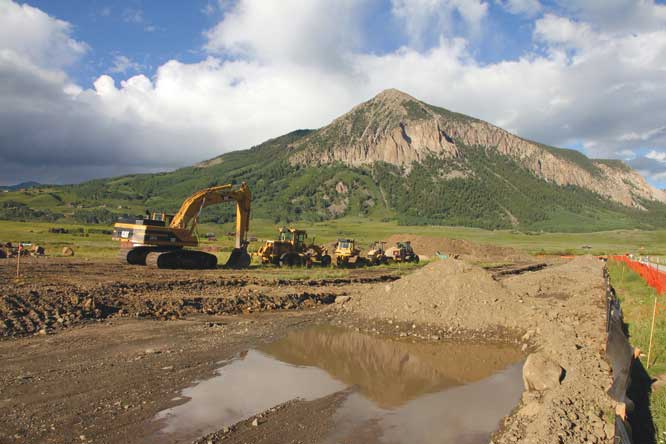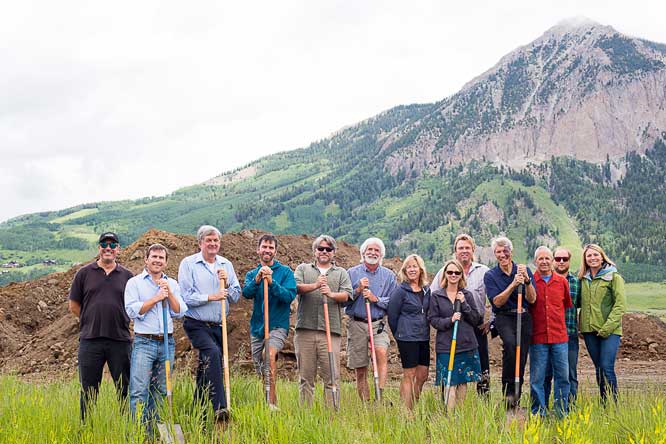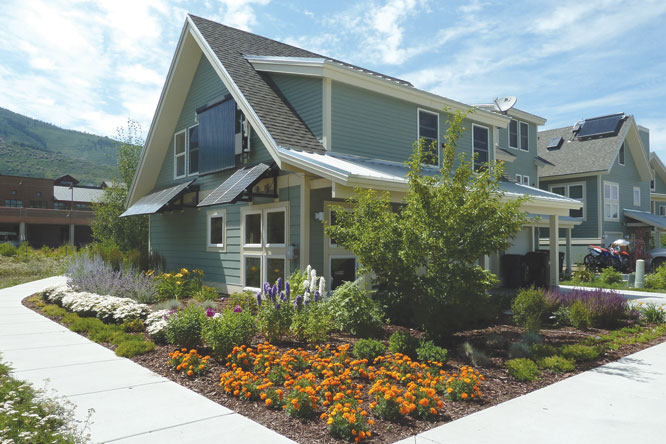by Adam Broderick
Editor’s Note: There is more to living in a resort town than the difficulty of finding a place or the long political discussion over how to provide so-called affordable housing. Reporter Adam Broderick looks at different angles of the issue in this summer series that explores what it’s actually like to live in deed-restricted affordable housing in Crested Butte and Mt. Crested Butte.
Last week we discussed the future of affordable housing at this end of the Gunnison Valley and explored some of the deed-restricted options that will be available in coming years. This week we revisit the current housing situation and its effect on local business; get to the bottom of rumors about deed restrictions and why they may have been lifted in the past; discuss loan potentials and requirements with a local banking expert; and wrap up this four-part affordable housing series with open minds, open hearts, half-empty wallets, and hopes for a future in paradise as we know it—er, envision it. And if you haven’t quite picked up what I’ve been laying down this past month, catch up with the series by following the link at the end of this story.
As we have seen in Crested Butte and Mt. Crested Butte, as well as other mountain resort towns also feeling the housing crunch, deed-restricted affordable housing is enjoyed by some and would be greatly appreciated by many more. As one deed-restricted homeowner said, “I’m able to live in this amazing community and pay all my bills and not struggle to live here like some other people who aren’t as fortunate.”

As for the future of affordable housing at this end of the valley, town planner Michael Yerman says that lies in collaboration with the county. And according to Russ Forrest, assistant county manager for community and economic development, unlike many other mountain resort communities, we still have land opportunities in much of Gunnison County. A needs assessment study is being conducted to determine exactly who in the county needs exactly what, and so far the only real conclusion is that the Rural Transportation Authority connects the county and creates infrastructure to strategically place more housing.
In the meantime, some local businesses are doing what they can to help their staff afford housing, and others are beginning to explore the concept.
Local businesses feel the pain
Crested Butte Lodging has gone a step above to offer affordable housing to their employees. Alex Summerfelt works the front desk and says he and his roommate each pay $500 per month, the same as he paid while going to school in Colorado Springs, only now he’s right at the base area of the ski resort.
“Employees are required to put in at least 32 hours per week, whether that be at the office or doing maintenance or housekeeping,” Summerfelt says. Crested Butte Lodging rents various long-term condos on the mountain, which are held on retainer for employees only. Summerfelt says five employees currently use the service.
Jeff Graceffa, co-owner of The Secret Stash, firmly believes the town of Crested Butte has lost something without having beds for the “local, true community” and that the lack of affordable housing has a direct effect on customer service in town as well as on quality of life. “We’re really diluting the local culture here. The locals are just getting swept aside,” he said. “We need quality of life to get people to stay for more than just one season so we don’t get this turnover every year. It gets expensive.”
The Secret Stash employs more staff than most restaurants in town, if not all of them. Manager Taylor Cone says housing is definitely an issue the restaurant has been dealing with lately and he thinks that problems they’ve had with hiring could be directly related to the housing shortage. As for whether The Stash has considered helping their staff better afford local housing, he said that for now they’re just trying to stick it out through summer. “But maybe that’s something we do need to talk about because it doesn’t seem the hiring situation is getting much better.”
Graceffa sees signs that The Stash isn’t the only one to feel the pinch. The Avalanche restaurant at the ski resort’s base area has offered breakfast, lunch and dinner for as long as he can remember, but is now offering only lunch.
“When I first moved to Crested Butte, my friends lived across the street and my employees lived here. There are fewer and fewer locals in the neighborhood these days and it makes this a less appealing place. I love Crested Butte. My whole life is vested in this place. But it’s really lost something to the short-term rental market, and it’s sad to see,” Graceffa said.
Avalanche owner Todd Barnes says his restaurant has not been open for dinners this summer because not enough staff can be hired. He also thinks the hiring problem is directly related to the lack of affordable housing in the area.
“We’re doing lunch from 11 to 4 and Wednesday night dinners when there’s music on the mountain and people up here,” Barnes said. “I left it up to the employees who would be around and who wanted to work, and the majority had days free. So that’s why we’re doing lunch instead of dinners. That way staff is out by 5:30 or 5:45 and can get to another job or go play outside. Also, there are more people up here during the day than at night. On Wednesdays, we all work doubles.”
Barnes said this summer he didn’t have one person come in saying the old phrase, “I just moved here and I’m looking for a job,” whereas normally 15 to 20 people say that and some people get turned away.
He let an employee go this summer because other staff didn’t like working with her. “We’re still offering the same quality of service. And I’m still on par for lunches from last year, even up just a little, but I don’t have the staff to be open any longer. I just hope this doesn’t continue through winter. Then what will we do? I hope all the skunk cabbage and century plants foretell a big snow year and that everybody forgets about this. I want to sell people food and booze and have a good time. It’ll be interesting to see what CBMR does. They employ the most people.”
Do deed restrictions last?
There has been some recent talk around town and in social media threads about the lifting of deed restrictions—why it occurs, how often, and how many more will be lifted in the future. This is what officials from different entities say has happened:
Karl Fulmer, executive director of the Gunnison Valley Regional Housing Authority (GVRHA), explained that in the event of foreclosure the deed restriction goes away, and most lenders require that. “As long as you’re credit-worthy and the deed restriction has a specific component saying the deed restriction goes away in the event of foreclosure, most lenders will go with that. We have a right of first refusal to save it from foreclosure,” he said.
As a home goes into foreclosure the deed restriction goes away, but the housing authority, the county or a municipality in the county gets first dibs to buy it out of foreclosure and not lose the deed-restricted unit.
Yerman says the long-term goal is to keep housing affordable for the future, so if you deviate from that you lose that affordability factor. He said the town of Crested Butte has never lifted a deed restriction.
In Mt. Crested Butte, Clayton says on a few occasions decisions have been made when affordable units went into foreclosure to not buy the units from the lender and save them. On each occasion, he said, the council looked at the unit and determined if it was a good or bad property to try to acquire and then resell.
“In one case, the unit was refinanced for more than the cap on the property. In another case, the unit was deed restricted for local ownership but there was no cap on pricing. A couple more were units where identical free market units were selling at lower prices than the deed-restricted units.”
Clayton says the town of Mt. Crested Butte has had several individuals come before the Town Council asking that they remove the deed restriction from a unit so that the unit would have a wider audience. In each case, he said, the council decided not to remove the restriction since that would set a precedent that they would remove deed restrictions in the future.
Forrest said there are a variety of deed restrictions within Gunnison County and that it’s not uncommon to lift them. “There are a lot of lessons learned with deed restrictions due to price appreciation, value caps, different definitions of locals… Through a foreclosure it can go to a bank and then that deed restriction can get stripped away. Deed restrictions are complicated and there are really good ones, and really bad ones. If they’re too convoluted, you can’t get a loan on them. It’s just too complicated and a lending institution won’t touch it.”
In 2009, county commissioners lifted deed restrictions on approximately 40 lots in the River Neighborhood of Skyland. When the restrictions were written, there was some language that left questions about whether the restrictions went with the property or ended with the first qualified buyer. There was no cap set on income earned by potential buyers, nor was there a cap on the sale price of the home. The only effect of the deed restriction put in place on those homes was that a full year had to go by before the houses could be resold.
“There was nothing about those deed restrictions that maintained affordability in any way or was in line with the county’s affordable housing goals. It was a local’s deed restriction but not an affordable housing restriction,” county manager Matthew Birnie said. “When those homes went to resell with no price control, they were much more valuable than the original price. They were no longer affordable as commissioners saw them.”
Commissioners did not think the covenants could be revived since they were not upheld from the beginning, which the commissioners believed left homeowners unaware of the details of the deed restrictions on their homes, so the board decided to lift the restrictions and allow homeowners in the River Neighborhood to sell their homes on the free market. Several of those homeowners claimed to be in serious financial danger, and although Jim Starr, then a commissioner and currently the chairman of the Gunnison Valley Housing Foundation, said it wouldn’t have been fair to hold the owners to restrictions they were supposedly not informed of, he was not happy with the decision.
“We didn’t have enough deed-restricted housing then and we still don’t. It was tough to get rid of those,” Starr said.
So yes, some deed restrictions have been lifted in both ends of the valley. Not in the town of Crested Butte or in Mt. Crested Butte, but elsewhere and for different reasons that seem to be justified by the decision makers.
Bank loans for deed-restricted homes
I spoke with Craig Bryant, the executive vice president of Gunnison Savings & Loan, to get a better feel for requesting a loan and purchasing a deed-restricted home. He says loan requirements for deed-restricted home purchases are no different from other home purchases. Having a decent credit history plus the income sources to be in a reasonable financial position to support the home and make the payments should do it.
Bryant says Gunnison Savings & Loan doesn’t put any requirements on their loans (such as requiring income to be earned locally) and that they often use co-borrowers to add financial strength and credit history to help get people qualified. That would be similar to a co-signer on a rental agreement, only co-borrowers are more deeply committed. As for the difficulty getting a loan, Bryant says that varies.
“There are more lenders out there in the “big world” that do not include deed restricted homes as being acceptable collateral. Exactly why that is, I’m not sure, but the services don’t want to deal with the deed restrictions, in the foreclosure process specifically,” Bryant said. “If everyone made their payments there wouldn’t be a problem. We at Gunnison Savings & Loan have always supported that process and have made several loans for deed-restricted homes. The loans have performed as expected, and people have an appreciation for the opportunities they’re given in a deed-restricted marketplace.”
There is not a typical interest rate for deed-restricted home loans. Those will vary, and Bryant said borrowers can get both long-term fixed-rate loans and adjustable rate loans, depending on their preference.
For potential buyers, Gunnison Savings & Loan gives free consultations. According to Bryant, “Everybody has to cross the line where they’re both mentally and financially in a position to buy a home because it is a long-term commitment, and we help people determine whether or not they’re ready at this time. If they’re not quite ready, we help them analyze their situation and decide what they need to do to get ready to buy a home. We don’t charge for an inquiry.”
That’s what Gunnison Savings & Loan could do for potential buyers. But GVRHA’s Fulmer says Wells Fargo is also good option. “Wells Fargo certainly lends fairly frequently on deed-restricted units throughout the state,” he said.
Anyone considering a deed-restricted home purchase in the town of Crested Butte should contact Michael Yerman at myerman@crestedbutte-co.gov, since he is compiling a master list of interested buyers for potential housing on the town’s blocks 79 and 80. Eligibility requirements will be available in October or November of this year. Yerman says staff is investigating qualifying buyers who earn up to 160 percent AMI (average median income), which for a single person in 2015 would mean $80,320 per year, but will be discussing the income qualifications with the Town Council in October. Applications are estimated to be accepted beginning January 2016.
So there you have it. The county, the municipalities within, and some local organizations are making efforts to create more affordable housing for the local workforce. Affordable housing is a valley-wide issue that rides the economical tides, and is a challenge facing most mountain communities, not just this one. It requires a community working together to address such an issue, and as we’ve learned throughout this series, this valley is beginning to unite and work toward solutions. Other mountain towns are doing the same, often taking notes from one another’s efforts and experiences—from years past, from current projects and from goals for the future. A future that, as we’ve learned, looks quite grim if the effort does not occur community wide. Thanks for caring enough about the community we live in to stick with me through this four-part series. It’s a cold world out there, and it’s been rather wet lately. Let’s help each other stay warm.
To read this feature series in its entirety, visit crestedbuttenews.com/?s=living+the+resort+town+life
 The Crested Butte News Serving the Gunnison Valley since 1999
The Crested Butte News Serving the Gunnison Valley since 1999



